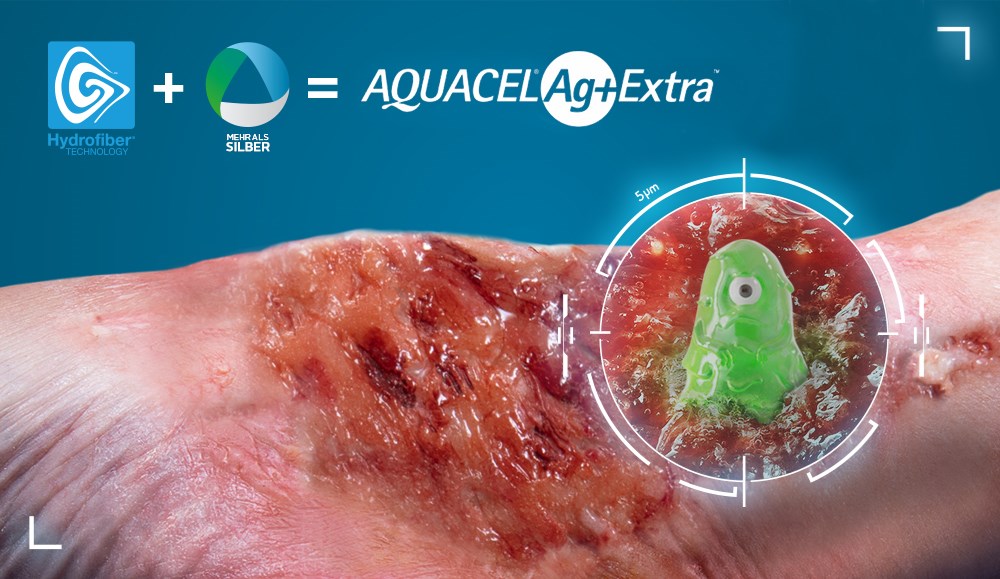AQUACEL® Ag+ Extra™ mit der MEHR ALS SILBER™ Technologie
AQUACEL® Ag+ Extra™ Wundverbände

Nehmen Sie Biofilm in Angriff
Im Kampf gegen chronische Wunden gibt es einen unsichtbaren Feind. Biofilm ist eine Hauptursache der chronischen Infektion9 und blockiert die effektive Wirksamkeit von Antibiotika und Antiseptika.10
- Mindestens 78% aller chronischen Wunden weisen Biofilm auf.8
- In 75% der stagnierenden Wunden wurde Biofilm nachgewiesen.
Die MEHR ALS SILBER™ Technologie wurde speziell entwickelt, um den Kampf gegen Biofilm zu gewinnen. Sie enthält drei Komponenten: ionisches Silber, ein Tensid und einen Metallchelatbildner. Diese wirken synergistisch zusammen und bieten eine überlegene Anti-Biofilm Wirksamkeit.26
![]()
Der Kampf gegen chronische Wunden ist notwendig
Schätzungsweise sind 1% der Gesamtbevölkerung in den Industrieländern betroffen1 und es ist zu erwarten, dass chronische Wunden aufgrund alternder Bevölkerungen sogar noch zunehmen werden.2,3
| |
||
| Um eine Wunde zu versorgen, entstehen pro Jahr Kosten etwa in Höhe von 6.000€ - 10.000 €. Schätzungs-weise entfallen in Europa 2-4% der Ausgaben für die Gesundheitsversorgung auf den Bereich der Wundversorgung.4-7 |
| Für Patienten mit chronischen, stagnierenden Wunden werden besorgniserregend hohe6 Antibiotika Verordnungsraten erreicht (60% - 75%).4,5 |
| Die Kosten pro Patient mit einem diabetischen Fußgeschwür sind 4x höher, wenn zusätzlich eine Infektion vorliegt – verursacht zum größten Teil durch Antibiotika, Amputationen und Klinikaufenthalte.7 |
![]()
Jetzt mehr über Biofilm erfahren:
- Sen CK, Gordillo GM, Roy S, et al. Human skin wounds: a major and snowballing threat to public health and the economy. Wound Repair Regen. 2009;17(6):763-71.
- Ortman JM, Velkoff VA, Hogan H. An Aging Nation: The Older Population in the United States: U.S. Department of Commerce; 2014 [Available from: https://www.census.gov/prod/2014pubs/p25-1140.pdf (assessed 16 January 2018).
- Rosenthal RJ, Morton J, Brethauer S, Mattar S, De Maria E, Benz JK, et al. Obesity in America. Surg Obes Relat Dis. 2017;13(10):1643-50.
- Tammelin, A, Lindholm, C, Hambraeus, A. Chronic ulcers and antibiotic treatment. J Wound Care. 1998; 7:435-437.
- Gürgen, M. Excess use of antibiotics in patients with non-healing ulcers. EWMA Journal. 2014; 14:17-22.
- Bowler PG. Antibiotic resistance and biofilm tolerance: A combined threat in the treatment of chronic infections. J Wound Care. 2018; 27:273-277.
- Prompers L, Huijberts M, Schaper N, Apelqvist J et al. Resource utilisation and costs associated with the treatment of diabetic foot ulcers. Prospective date from the Eurodiale Study. Diabetologica, 2008; 51:1826-1834.
- Malone M et al. 2017. The prevalence of biofilm in chronic wounds: a systematic review and meta-analysis of published data. JWC; 20-25.
- Wolcott R, Sanford N, Gabrilska R et al. Microbiota is a primary cause of pathogenesis of chronic wounds. J Wound Care WUWHS Suppl 2016:25(10): S33-S43.
- Percival SL, Bowler PG, 2004. Biofilms and their potential role in wound healing. WOUNDS, 16: 234-240.